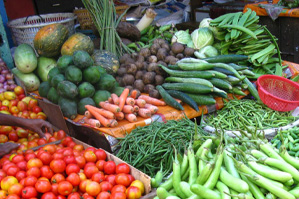An apple a day keeps the orthopedist away

 If I were to ask you how to protect yourself from osteoporosis, what would you say? Probably something like, “drink more milk,” or “take a calcium or vitamin D supplement,” right? I recently met with Katherine Tucker, professor of nutritional epidemiology in the department of health sciences, and she said that while calcium and vitamin D are important, they are just two of a whole host of important nutrients. How we get them is just as important (if not more important) as how much we get.
If I were to ask you how to protect yourself from osteoporosis, what would you say? Probably something like, “drink more milk,” or “take a calcium or vitamin D supplement,” right? I recently met with Katherine Tucker, professor of nutritional epidemiology in the department of health sciences, and she said that while calcium and vitamin D are important, they are just two of a whole host of important nutrients. How we get them is just as important (if not more important) as how much we get.
Osteoporosis occurs as our bone mineral density diminishes, said Tucker. Bone is not a static thing as many people think, but rather an active tissue that is constantly remodeling itself — breaking down and building up. Over time, if our rate of bone breakdown outpaces that of buildup, we have a problem. Bone mineral density is a strong predictor for hip fracture among older adults, which is itself associated with 20 percent excess mortality. Fifty percent of hip fracture patients will never walk on their own again, Tucker told me, leading to immobilization, reduced metabolism, and general decline in health.
So, how can we avoid these serious concerns as we age? Turns out calcium pills alone likely won’t do the trick. Tucker’s epidemiological analyses of data from several studies show that calcium and vitamin D supplements will help maintain bone mineral density while we’re taking them, but as soon as we stop, we return to the same level of bone loss as we would if we’d never taken them. “Flooding the system helps,” she said. “But you must take it forever.”
Another common misconception about bone health is its relation to protein. For a long time, doctors have associated high-protein diets with osteoporosis because they saw high calcium concentrations in the urine of people given high doses of protein in the laboratory. Tucker’s analyses with her colleagues in the Framingham Osteoporosis Study have shown that high protein diets actually lead to the least amount of bone loss in older adults. “This is why epidemiological studies are so important,” said Tucker. “You have to do the research in free living populations to see what’s really happening.” Short term studies looked at the metabolic outcomes of high protein diets, and inadequately associated them with long term effects.
But protein is acid-producing in the blood, said Tucker. This means we need other nutrients, like magnesium and potassium (which are buffers) to be maintain a good acid/base balance. Unfortunately, more than half the population does not meet the recommended daily value for these. Tucker decided to take this knowledge and use it further studies, exploring whether people who did in fact have good magnesium/potassium levels had stronger bones. Using the same population data, Tucker found that this was indeed the case.
And where do magnesium and potassium show up in the diet? Fruits and vegetables — those foods that Americans are very poor at including in our diets. Tuckers’ was one of the first studies to show that fruits and vegetables are related to, and even critical to, bone health. The message has been widely received by the research community, she said. But doctors and the general public are another story.
Turns out moderate alcohol consumption, particularly red wine, is also good for the bones, as it contains antioxidants which minimize oxidative stress and inhibit bone breakdown. Eating fruits and vegetables also contributes antioxidants like carotenoids and vitamin C,-which Tucker and her colleagues have shown over the years to protect bone mineral density and reduce risk of hip fracture.
Minimizing your cola intake is another good idea if you’re on a bone health kick. The problem here isn’t sugar, it’s phosphoric acid. So even diet cola is a problem when it comes to bone density. That’s because phosphoric acid, which is used as a flavor additive in colas (and Mt. Dew), disrupts the acid-base environment of the body without also introducing the balancing compounds necessary to prevent bone-breakdown, said Tucker.
I asked Tucker if osteoporosis was more prevalent in societies that have diets low in fruits and vegetables. While she wasn’t willing to make a causative statement there, she did say that the United States and Northern Europe have the highest rates of hip fractures and that cultures that don’t even have dairy as a part of their diet tend to have the lowest rates of hip fractures.
Her team is now pursuing studies around dairy intake with the same Framingham Osteoporosis Study data.





